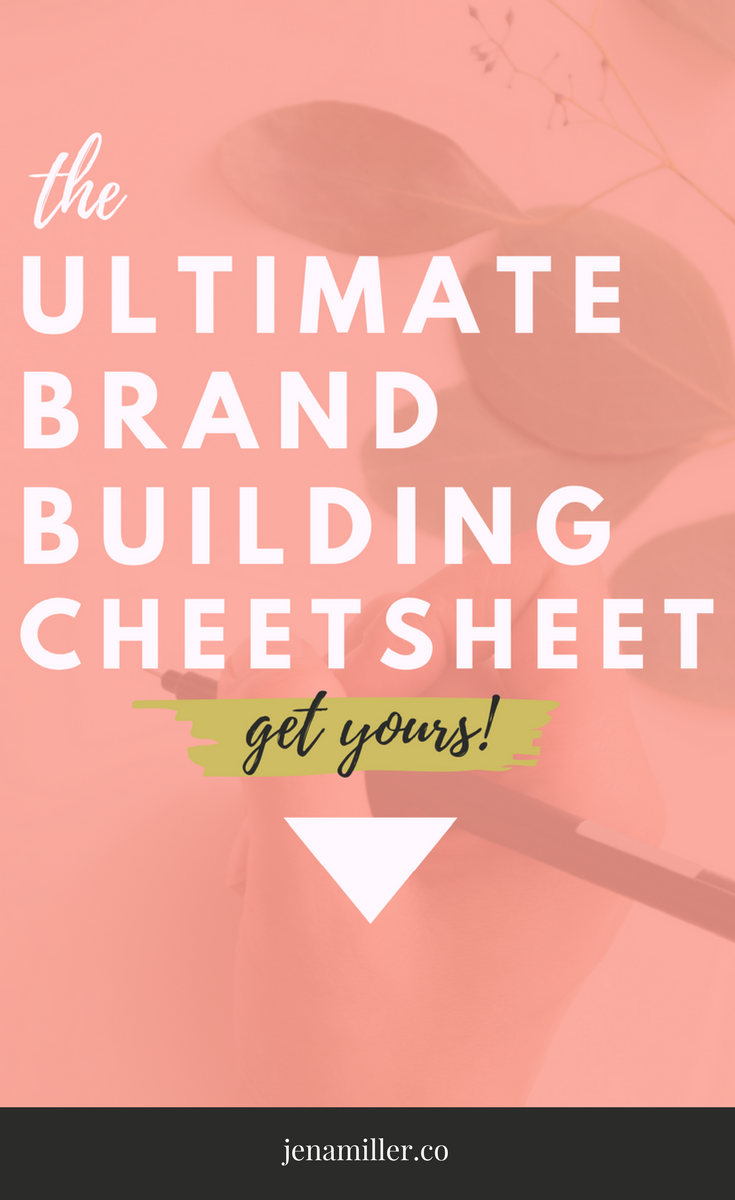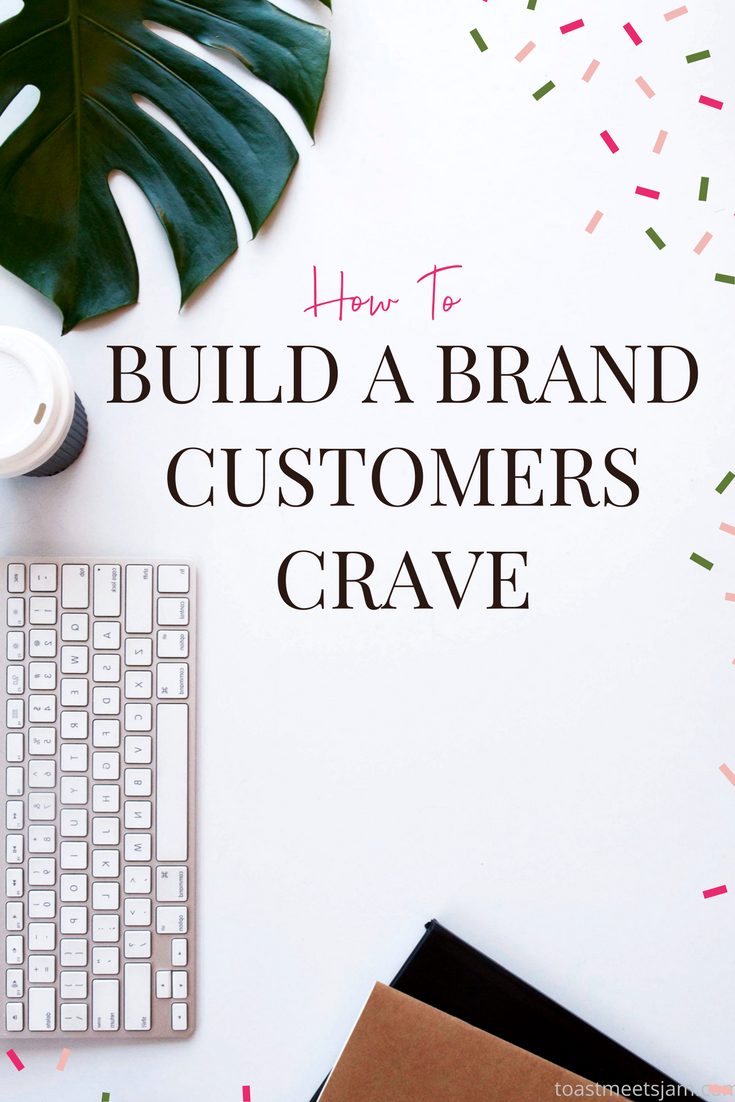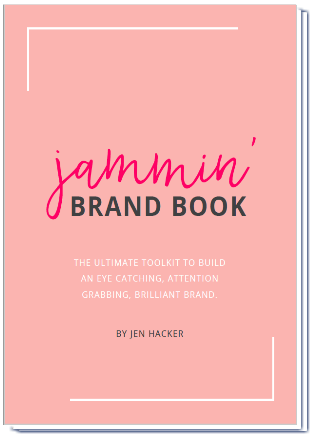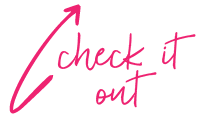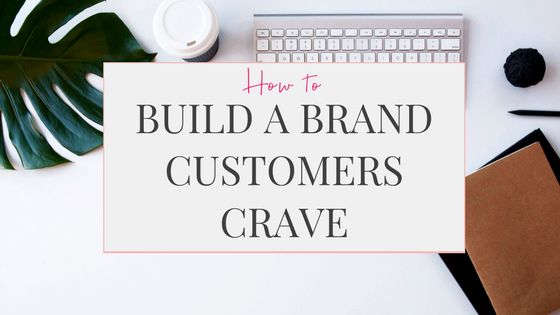
This comprehensive guide is here to teach you everything you need to know about how to build a brand.
Intro
You had an idea and an entrepreneurial itch so you decided to go for it.
Before you knew it your venture was in motion and things started to happen, fast. Strategy and long term planning fell to the wayside as the day to day realities of running your business took center stage.
Now, things are going pretty well but you’re craving more. You look at some of your favorite brands and wonder what it would take to reach their level of success; to grow a following of loyal fans, keep customers coming back for more, and attract the attention of top media.
Trust me, I’ve been there and I get it.
I started Toast Meets Jam 4 years ago as a blog called The Single Diaries. (That’s a story for another time). Once things were going, trying to control them and stick to a plan for more than a few weeks became out of the question. The brand kept changing and things were anything but consistent. I finally decided that if I wanted to turn this blog into more than a passion project that I’d need to make a serious change. In July I committed to turning Toast into a full fledge business with a solid brand behind it. This is me coming out on the other side, ready to share everything I’ve learned.
You’ve probably already read a lot of articles with tips and strategies to grow your brand but always end up feeling overwhelmed. The goal of this post is to take away your doubts. I’ve put in the hard work so you don’t have to.
Because you know what?
Nailing your branding doesn’t have to be intimidating.
With a roadmap and specific actionable advice to follow, building your brand can actually feel totally achievable. And the payoff will absolutely make the effort worthwhile. Investing in your brand is a surefire way to scale your business and create more meaningful and profitable relationships with your customers.
So here we go. Download this FREE Brand Building Cheat Sheet which breaks the brand-building process down into 10 manageable steps and we’ll walk through each right here together.
When we’re done you’ll know exactly how to turn your business into a brand that customers crave. Ready? Let’s jam.
How to Build a Brand – 10 Steps to Brand Building Success
1. Really get to know your customers
Building a brand is about creating a community with the people we serve. In order to do that, we need to understand how to relate to them. That means getting to know them as friends, not just as a set of stats about their age, gender, and occupation. What’s the most important thing in their lives? What do they lose sleep over? You want to learn exactly who your customers are, what they like to do, what motivates them, and how they want to engage with brands like yours.
“
57% of small business owners say that having a relationship with their consumers is the primary driver of repeat business. (source)
“
So how do you do get to know your customers?
First, refer to your analytics. Google, Facebook, and Instagram all have amazingly detailed data to share around who is engaging with your brand online. Then,, conduct free market research by using your social media feeds to poll your audience. Ask easy to answer questions like “do you prefer A or B” or “In the comments tell me your favorite thing about X”. It’s real-time feedback at your fingertips. Next, scan the comments in blogs, Amazon books, and social media profiles that you believe share a similar audience. See what questions people ask, what complaints they have about the content, and what things they are blown away by. Lastly, use Quantcast to gather deeper information about these same audiences.
Turn your findings into customer segments.
I like to use a Google spreadsheet to keep track of the data that I collect. My workbook has one tab where I copy and paste direct quotes and comments that I find. A second tab categorizes critical information with rows labeled for age, location, interests, wishes, and frustrations. You’re looking for patterns that start to identify the different kinds of customers you serve. There will likely be more than one but you should try and keep your focus narrowed to no more than 4. Otherwise, you’ll find yourself not able to get specific enough in your communications.

Then turn these into customer personas.
The final step is to take these segments and turn them into customer personas. This is really just a fancy way to talk about writing characters for each of the types of customers you’ve identified. Give each a name and write a bio that describes who they are, what they like, dislike, and hope to achieve.
HOT TIP! Grab a free customer persona template here.
2. Write your brand story
Storytelling is a part of human nature. We’re curious. We like to know the history and reason for things.
Believe it or not people really do care about the story behind your business. It’s why Netflix just released Girlboss, a new show loosely based on the story behind Sophia Amoruso’s Nasty Gal. It’s also why people can’t get enough of the Kardashian- Jenner clan. We know their story so intimately we feel like we’re a part of it.
When you share your story people are able to develop a trusting relationship with you. Think about it, would you rather buy something from someone you know nothing about or someone you know, trust, and like? I think we’d all vote for the latter.
How to write your brand story:
Writing your brand story doesn’t have to be hard. Tell it like it is and fill in the who, what, how, and why for your audience. Who are you and what’s your background? What was the catalyst for your business? Why did you feel compelled to see it through? How did you do it and what challenges did you overcome along the way? The biggest key to success is just to be honest.
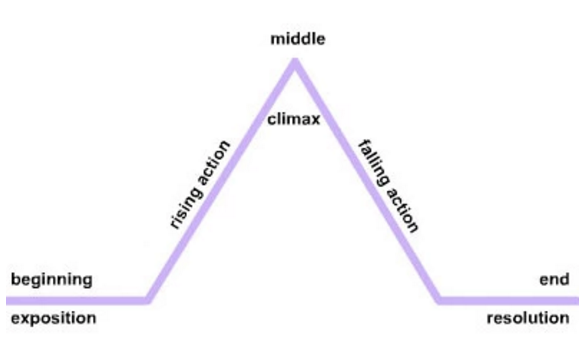
Source: https://pluribusprofundis.wordpress.com/tag/story-arc/
Using your brand story IRL:
Once you’ve drafted your story there’s three places I want you to start using it. First, add it to an “About” page on your website. Second, include it on a separate sheet in your media or press kit. Third, write it into your brand book. The point is for this to become a tale that is shared and repeated. Your goal is to reach a point that your fans, partners, and press can tell it as well as you can. When that happens you know you’ve got them hooked.
HOT TIP! Get your free brand story template here.
3. Establish your brand mission
One of the things you’re going to uncover as you’re writing your brand story is your brand “why”. That is, why you do what you do? Why are you building this brand in the first place?
The way the answer to that question often manifests itself is in your mission statement. I like to think about your brand mission as the most important promise you will make to your customers. It is a declaration of what you’re going to do for your customers and how you plan to make it happen.
Your mission reveals your values.
Your mission is also where you begin to introduce your brand values. It’s an important opportunity to reveal what you care about and will deepen the emotional bond you have with your core customers.
Let’s take Brit + Co as an example. Their brand mission is to “ignite the creative spark in women”.

Wow! Right? Doesn’t that make you want to be a part of their community? I mean I for one want my creativity sparked.
Brand mission statement formula:
Ok, now try using this formula to write your own brand mission statement:

When you’ve written yours bring it to life by including it in your website both on your “About” page as well as in your “Hiring” page.
HOT TIP! Here are 20 examples of brand mission statements to inspire you
4. Get crystal clear on your brand equity
People don’t fall in love with brands because of what they sell. They fall in love with what a brand promises to do for them and how that brand makes them feel. In marketing lingo this is often referred to as a brand’s equity. It’s what a brand stands for in the hearts and minds of consumers.
So how do you begin to stand for more than what you sell? Great question. It’s about delivering on your mission statement through your words and actions. It’s how you talk to your customers, the content you put out in their social media feeds, the bigger impact you have on the world, and ultimately every little interaction someone has with your brand.
As an example let’s look at Jen Gotch’s brand Ban.do:

Their equity is really encapsulated in that last line “We are serious about fun.”. Ban.do sells office supplies and desk accessories that deliver on this promise through quirky patterns and catchy quotes. They also keep the vibe alive with bright colors and graphics in their social posts and a generally playful vibe wherever they pop up.
Okay so let’s get to it.
To figure out what your brand equity is I like to use this 5 step framework:
- First, list the tangible products and services your brand creates or provides.
- Second, write out your brand’s unique points of difference – the reasons someone would choose you over another brand.
- Third, decide how you want your brand to make people feel.
- Fourth, describe the traits your brand would have if she were a person.
- Fifth, summarize this all in a short statement that describes what your brand stands for.
Going through this process should help you see how the different parts of your brand all come together. You can then use this framework to evaluate whether something like a new product, partnership, or even a social media post helps or hurts the equity you’re working to establish.
HOT TIP! Get a template for the 5 step framework here.
5. Create a brand design that wows
Research reveals that we make a subconscious judgment about something within 90 seconds of seeing it (source). Meaning, like it or not, we can’t seem to stick to the old adage “don’t judge a book by its cover”. As human beings, we’re prone to make decisions on subliminal cues or “unconscious bias” as the author Malcolm Gladwell puts it. That means we need to make an awesome first impression every time someone encounters our brand. It may be our only chance to establish trust and validate our credibility with potential customers.
An awesome first impression begins with your brand design. It’s the outward expression of your equity that brings to life your brand’s personality. Great design can help create an immediate sense of trust and authority while poor design can detract from even the best brands.
Start with a mood board.
The first step in developing your design theme is to create a mood board which is a simple visual aid for bringing to life the look and feel of your brand. An easy way to build one is with Pinterest. Just create a new board and then begin to pin pictures that you feel reflect your brand personality.

The mood board sets the visual tone for your brand.
Reference it when you’re selecting images for everything from your website to an Instagram post. Your mood board is also where you can draw inspiration for the core elements of your brand design. Choose 4-5 colors that compliment each other. Tip: I like to use Mac’s Digital Color Meter tool to pick out colors directly from the images in my mood board. Then choose 2 – 3 font styles that you see repeated in your pictures. Font Pair is another great tool for picking out fonts that go together.
Once you select your elements stick with them and use them everywhere your brand shows up. To help drive this home I recommend documenting your choices in your brand book.
HOT TIP! See best practices from brands with amazing brand design.
6. Find your authentic brand voice
Of course, visuals are the only way one to communicate with your customers. The other is through your words. It seems pretty straight forward but for a lot of people finding the perfect tone of voice is actually one of the most challenging parts of the brand-building process.
So here’s my easy hack. Imagine how you’d talk to your customers if you met them at a party. Then, read out loud as if you actually are talking to them while you’re writing. I find that doing this really helps your words to come out more naturally.
Coin your signature sayings.
Another trick I like to use is to come up with a handful of signatures words and sayings. Think about how Sophia Amoruso coined GirlBoss and the word caught on like wildfire. That’s exactly what I’m talking about. The reason this trick is so powerful is that a shared language builds community amongst you and your followers. It creates a sense of belonging when someone recognizes and adopts the signature saying you’ve created.

How to develop your voice:
To develop your authentic voice start by brainstorming all of the words that reflect the brand equity and personality you’ve created. Write them down on whatever’s available to you whether that’s a whiteboard, Google doc or a notebook. When you’re done picking out the ones that really jump out. Aim to have a few words, phrases, and hashtags in your mix. I also recommend adding these to your brand book. Sensing a pattern here ; )
HOT TIP! Use this cheatsheet to find your brand voice
7. Create a consistent brand experience
Why do I keep harping on documenting things in your brand book? Because the real secret to stand out branding is consistency.
“
90% of consumers expect the customer experience to be consistent across all channels and devices used to interact with brands. (Source)
“
Consistency makes your brand memorable.
It also builds trust. Both are critical when cultivating a loyal audience. Remember, you’re in your brand every moment of every day. Your customers are not. Even though you might be growing tired of how your brand looks, talks, or feels, chances are it’s only the first time someone is coming across these things. When they see you a second time, you want to make sure there’s no confusing who you are.
Your brand book is your best friend.
A brand book is a tool that helps you document and share your brand choices so that everyone who creates something on behalf of your brand does so in the same way.
Conduct a brand audit.
Now would be an excellent time to conduct an audit of how your brand is showing up on and offline. Are you using the same brand name everywhere you show up online? (logo, website URL, social handles, email address)? Have you picked a color palette and are you sticking to it? Have you picked specific fonts and are you using them consistently? Are you using the same or similar explanations for every brand bio?
8. Develop original brand content
First things first, get your house in order. Your goal is to answer “yes” to every one of the questions above. From there you’re ready to take what you’ve learned and apply it to the creation of original content e.g. blog posts, emails, social media posts – anything your brand creates and shares with your customers.
And why is creating original content so important? Because:
“
62% of millennials feel that online content drives their loyalty to a brand (Source) and the more frequent your interactions the more loyalty you gain (Source).
“
Creating original content helps your brand extend beyond the products you sell. It gives you a way to show your customers that you’re not all about business. That you actually care about them and you’re not just in it for the sale.
Create for your customers.
Bearing that in mind, before you get started creating content your first step should be spending time to understand what your customers are interested in. Good news! You should have this in hand from step 1 where you created your customer segments and personas.
From there it’s about picking the right platforms and messages for each. Here’s what I do. First, create a spreadsheet and list all of the places you talk with your customers across the top row. For instance, you might include your blog, Twitter, Facebook, email, and Instagram. Then in each column, list what kinds of content your customers would find helpful to find there. For Toast Meets Jam Instagram is where I’ve chosen to share inspirational quotes, tips, and a look behind the scenes. Twitter, on the other hand, is where I share other experts’ articles that I think my audience would benefit from and Youtube is where I share interviews with female founders.

Get creating!
Once you’ve nailed down what kinds of content you want to fill your channels the next step is to get creating! Canva is an awesome tool for creating beautiful original content. And pro-tip, if you upgrade to the paid version you get access to thousands of stock photos you can use to give your posts even more pizazz.
9. Attract your brand tribe
At this point, you’ve identified your core customers, you’ve got a brand designed to delight them, and content you know they’re going to love. The next step is to find and attract those people to your brand.
Here’s how you’re going to do it.
Your first step is to find out where your customers are already hanging out online. The tool you’re going to use to do this is called BuzzSumo. This site allows you to search for topics and websites. If you search a topic like “women entrepreneurs” it will show you a list of which articles were the most shared across the web on that topic. It will also show you where those articles were shared (Facebook, Twitter, Pinterest and Google +). This will uncover which websites are attracting readers interested in that topic. It will also show you which social networks conversations around the topic are happening the most frequently.

Step 2
Next, I want you to become an active, helpful, and engaged member of the communities you identify. Regularly read the content that these other sites are posting, leave comments, join their Facebook groups if they have them, and share your favorite posts of theirs.
Step 3
At this point you can begin to introduce their audience to your brand and your content. You want to do this in a way that is helpful and not spammy. That means leaving a thoughtful comment and at the end mentioning that you have a product or a blog post that you think they might be interested in checking out. You’re subtly bringing people over to you.
Step 4
Finally, you’ll want to apply this same approach with your audience once you’ve started to build one. Regularly check your analytics to see which types of content people are loving the most and produce more of it. Engage with your audience around those topics and do what you can to be even more helpful for them in those areas.
Ultimately building a brand is about creating a community around a shared passion. Everything you’re doing now is intended to help foster relationships and create brand love.
10. Grow your brand awareness
One thing I want to clarify about the last step is that it’s not at all meant to be malicious. You are not stealing customers away from your competition. You want to be genuinely helpful and consequently, your engagement should actually benefit them. Sharing their content will help them get in front of a bigger audience. And engaging with their posts will help stir up more positive activity (comments, shares, likes) within their community.
The power of partnerships:
There’s a reason I emphasize this. It’s because I want you to get you to start thinking about how you can grow your brand through partnerships. This is about collaboration over competition. For that reason, I want you to build relationships with the people behind the sites you’ve been supporting. You’re going to do this in order to drum up opportunities for you both to continue to support each other and help one another grow. It’s really a big love fest in the end.
Go ahead and direct message these other brand owners through Twitter, Facebook, or Instagram or shoot them an email. Introduce yourself, let them know how much you love their brand, and suggest a partnership. Try and be specific here in order to make it as easy for them to say yes as possible. You could cross-promote each other on social media, host a joint giveaway, create a video together, the ideas are endless. The aim is to do something that each of you and your customers will benefit from.
Partnerships are the not so secret trick of the trade for building a stand out brand. Don’t think that you need or should be on your journey alone. The more people you can involve the faster and bigger you’ll see your brand-building efforts pay off.
HOT TIP! Steal these 20 ideas for your next brand partnership
To Wrap it Up
When you take time to build your brand you’re making an investment that will take your business to the next level. As a result, you’ll stand out from the crowd. You’ll find and attract your fan club. And you’ll feel completely confident that what you have to offer is awesome.
And while there is a lot packed into that tiny word “brand” learning how to build a brand doesn’t have to be stressful. Most of all it’s all about taking it one step at a time.
Ready to dive in? Download this FREE Brand Building Cheat Sheet and use it as your guide to become the boss of your brand.
What are the biggest challenges you face when it comes to how to build a brand? Let me know in the comments below!

